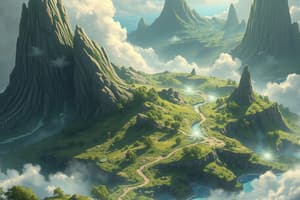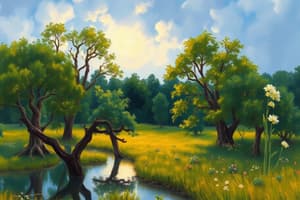Podcast
Questions and Answers
Which biome is characterized by having very cold temperatures and significant snow and ice in winter?
Which biome is characterized by having very cold temperatures and significant snow and ice in winter?
- Desert
- Savanna
- Tundra (correct)
- Shrubland/Chaparral
What type of trees are typically found in the Taiga/Boreal Forest biome?
What type of trees are typically found in the Taiga/Boreal Forest biome?
- Cacti
- Deciduous trees
- Palm trees
- Conifer and Evergreen trees (correct)
Which biome experiences a very low amount of rainfall, primarily characterized by temperature extremes?
Which biome experiences a very low amount of rainfall, primarily characterized by temperature extremes?
- Savanna
- Shrubland/Chaparral
- Desert (correct)
- Taiga/Boreal Forest
What is the primary feature of the savanna biome?
What is the primary feature of the savanna biome?
Which biome is heavily influenced by fire and features evergreen shrubs?
Which biome is heavily influenced by fire and features evergreen shrubs?
Which biome is known for having permafrost soil that is currently melting due to climate change?
Which biome is known for having permafrost soil that is currently melting due to climate change?
What characteristic is typically observed in the climate of shrubland/chaparral biomes during the summer?
What characteristic is typically observed in the climate of shrubland/chaparral biomes during the summer?
In which major locations are deserts primarily found?
In which major locations are deserts primarily found?
Which biome is characterized by warm summers and cold winters with high precipitation throughout the year?
Which biome is characterized by warm summers and cold winters with high precipitation throughout the year?
What is a significant feature of Temperate Grasslands?
What is a significant feature of Temperate Grasslands?
Where are Tropical Rainforests primarily located?
Where are Tropical Rainforests primarily located?
Which of the following is true about Temperate Rainforests?
Which of the following is true about Temperate Rainforests?
What distinguishes Temperate Grasslands from other biomes?
What distinguishes Temperate Grasslands from other biomes?
Which biome features the highest biodiversity on land?
Which biome features the highest biodiversity on land?
What feature do temperate seasonal forests have that enhances soil quality?
What feature do temperate seasonal forests have that enhances soil quality?
What climatic condition is typically found in Temperate Grasslands?
What climatic condition is typically found in Temperate Grasslands?
What is meant by 'competition' in ecological terms?
What is meant by 'competition' in ecological terms?
What is a prerequisite for competition to occur between organisms?
What is a prerequisite for competition to occur between organisms?
What do termites provide their gut bacteria in return for digestion assistance?
What do termites provide their gut bacteria in return for digestion assistance?
Which of the following accurately describes the relationship between ants and acacia shrubs?
Which of the following accurately describes the relationship between ants and acacia shrubs?
In a predator-prey relationship, what role does the predator play?
In a predator-prey relationship, what role does the predator play?
What is the primary purpose of mimicry in prey species?
What is the primary purpose of mimicry in prey species?
What usually happens during competition for resources among organisms?
What usually happens during competition for resources among organisms?
In a commensalistic relationship, what happens to the non-benefiting species?
In a commensalistic relationship, what happens to the non-benefiting species?
What determines the structure of food webs in ecosystems?
What determines the structure of food webs in ecosystems?
Which of the following is an example of mutualism?
Which of the following is an example of mutualism?
What type of organism is a barnacle in relation to a whale in their interaction?
What type of organism is a barnacle in relation to a whale in their interaction?
How do predators adapt to become more effective over time?
How do predators adapt to become more effective over time?
What type of defense might a plant use to deter herbivores?
What type of defense might a plant use to deter herbivores?
Which characteristic defines an ectoparasite?
Which characteristic defines an ectoparasite?
Which of the following is an adaptation that prey might develop?
Which of the following is an adaptation that prey might develop?
How does the viceroy butterfly benefit from its resemblance to the monarch butterfly?
How does the viceroy butterfly benefit from its resemblance to the monarch butterfly?
What is the primary effect of parasitism on the host organism?
What is the primary effect of parasitism on the host organism?
In which type of relationship do both species involved gain benefits?
In which type of relationship do both species involved gain benefits?
What do endoparasites do in relation to their host?
What do endoparasites do in relation to their host?
What is the primary consequence of predation in an ecosystem?
What is the primary consequence of predation in an ecosystem?
Which of the following is a predator-prey relationship example involving animals?
Which of the following is a predator-prey relationship example involving animals?
What is a benefit that barnacles gain from attaching to whales?
What is a benefit that barnacles gain from attaching to whales?
What is a common strategy used by plants to protect themselves from herbivores?
What is a common strategy used by plants to protect themselves from herbivores?
What is an example of parasitism?
What is an example of parasitism?
Flashcards
Temperate Seasonal Forest
Temperate Seasonal Forest
A forest biome with moderate temperatures, distinct seasons, and high precipitation throughout the year. Trees lose their leaves annually.
Temperate Grasslands
Temperate Grasslands
A biome characterized by vast areas of grasses, limited rainfall, and extreme temperature variations throughout the year. Agriculture has greatly altered this biome.
Temperate Rainforest
Temperate Rainforest
A biome with abundant rainfall, mild temperatures year-round, and high biodiversity. Often found in coastal areas.
Tropical Rainforest
Tropical Rainforest
Signup and view all the flashcards
Polar Zone
Polar Zone
Signup and view all the flashcards
Temperate Zone
Temperate Zone
Signup and view all the flashcards
Tropical Zone
Tropical Zone
Signup and view all the flashcards
Major Locations of Biome
Major Locations of Biome
Signup and view all the flashcards
Savanna Climate
Savanna Climate
Signup and view all the flashcards
Savanna Feature
Savanna Feature
Signup and view all the flashcards
Desert Climate
Desert Climate
Signup and view all the flashcards
Desert Feature
Desert Feature
Signup and view all the flashcards
Tundra Features
Tundra Features
Signup and view all the flashcards
Boreal Forest Climate
Boreal Forest Climate
Signup and view all the flashcards
Chaparral Features
Chaparral Features
Signup and view all the flashcards
Climatograph Definition
Climatograph Definition
Signup and view all the flashcards
Mimicry
Mimicry
Signup and view all the flashcards
Predator-Prey Relationship
Predator-Prey Relationship
Signup and view all the flashcards
Herbivore
Herbivore
Signup and view all the flashcards
Symbiosis
Symbiosis
Signup and view all the flashcards
Mutualism
Mutualism
Signup and view all the flashcards
Commensalism
Commensalism
Signup and view all the flashcards
Parasitism
Parasitism
Signup and view all the flashcards
Adaptation
Adaptation
Signup and view all the flashcards
Community
Community
Signup and view all the flashcards
Species Interactions
Species Interactions
Signup and view all the flashcards
Competition
Competition
Signup and view all the flashcards
Resource
Resource
Signup and view all the flashcards
Predation
Predation
Signup and view all the flashcards
Adaptations for Predation
Adaptations for Predation
Signup and view all the flashcards
Adaptations for Prey
Adaptations for Prey
Signup and view all the flashcards
Impact of Predation
Impact of Predation
Signup and view all the flashcards
What is an ectoparasite?
What is an ectoparasite?
Signup and view all the flashcards
What is an endoparasite?
What is an endoparasite?
Signup and view all the flashcards
What does a parasite obtain from its host?
What does a parasite obtain from its host?
Signup and view all the flashcards
Triggerfish and smaller fish relationship
Triggerfish and smaller fish relationship
Signup and view all the flashcards
Barnacles and whales relationship
Barnacles and whales relationship
Signup and view all the flashcards
Study Notes
Terrestrial Biomes
- Terrestrial biomes are diverse ecosystems characterized by distinct climate, vegetation, and animal life.
- Latitude plays a crucial role in defining biomes.
- Latitude zones, including Polar, Temperate, and Tropical, dictate the specific characteristics of each biome.
Temperate Seasonal Forest/Deciduous Forest
- Found in Europe, Eastern China, Eastern North America, and the Great Lakes region.
- Characterized by significant rainfall throughout the year.
- Experiences warm summers and cold winters, with periods of freezing temperatures.
- Deciduous trees are a key feature, losing their leaves in the fall, leading to rich soil formation from decomposing leaves.
Temperate Grasslands
- Also known as prairies or steppes, located in North America and Russia.
- Receives limited rainfall, supporting grasses over trees.
- Experiences extreme temperature variations, from very cold winters to hot summers.
- A significant portion of this biome has been converted to agricultural land due to fertile topsoil.
- Topsoil formation occurred over thousands of years due to decaying herbivore waste and grass.
Temperate Rainforest
- Found in the Pacific Northwest of the US, South Alaska, and Japan.
- Experiences abundant rainfall.
- Characterized by mild temperatures year-round.
- Contains old-growth forests, vital for biodiversity, and is an economically important area for logging.
Tropical Rainforest
- Located near the equator across various continents.
- Receives abundant rainfall throughout the year.
- Remains hot year-round.
- Features exceptionally high biodiversity.
- Lush, dark, and damp environment.
- Has poor soil quality.
Savanna
- Primarily located in Africa.
- Experiences generally low rainfall, but has a distinct rainy season.
- Characterized by warm temperatures year-round.
- Grasses dominate due to limited rainfall.
- Savannas are home to large acacia trees.
Desert
- Found in various global locations around 30°N and 30°S latitude.
- Very low rainfall.
- Experiences extreme temperature differences between winter and summer.
- Organisms have specialized adaptations to survive the harsh conditions, including drought resistance.
- Some deserts feature barren landscapes with sand dunes, while others support drought-resistant shrubs.
Tundra
- Situated in high latitudes around the Earth's poles (Arctic and Antarctic).
- Receives very low precipitation.
- Experiences very cold temperatures and snow/ice during winter.
- Summers have brief barren periods, although vegetation exists.
- Day length is a key factor; little daylight in winter and abundant daylight in summer.
- Permafrost (permanently frozen ground) is a significant characteristic, influenced by climate change.
Taiga/Boreal Forest
- Found in Canada, Russia, Alaska, Scandinavia, and high mountain altitudes.
- Experiences moderate rainfall.
- Characterized by very cold winters and mild summers.
- Dominated by coniferous and evergreen trees (similar to Christmas trees).
- Animals often hibernate during harsh winter months.
Shrubland/Chaparral
- Found in Southern California, the Mediterranean region, Chile, and Australia.
- Receives low rainfall, but more than deserts.
- A unique characteristic is almost no rain in summer.
- Features evergreen shrubs.
- Adapted to and dependent on fire.
Climatographs
- Special graphs displaying precipitation and temperature patterns for specific biomes.
- Allow for a visual representation of climate patterns over time.
- Used for recognizing patterns related to biomes and comparing with climatographs.
Studying That Suits You
Use AI to generate personalized quizzes and flashcards to suit your learning preferences.




